After disappointing scallop seasons in 2019, ’20, outlook remains bleak ahead of November harvest

In June, Matt Ketcham was harvesting oysters at his underwater farm in Southold Bay, when he beheld the welcome sight of adult bay scallops in his oyster cages. (He threw them back.) He’d also been noticing a lot of scallop spat; babies born during the once-a-year spawn. These were promising signs for the 2021 bay scallop harvest that commences the first Monday in November. But by the end of August he wasn’t seeing scallops.
Mr. Ketcham wasn’t the only bayman seeing hope in 2021, especially welcome after the abject disappointment of the 2019 and 2020 seasons. Those failed harvests led the U.S. Secretary of Commerce to declare that New York’s bay scallop fishery qualifies as a fishery resource disaster, making it eligible for disaster assistance.
Last week, Steve Tettelbach, head of Cornell Cooperative Extension’s Peconic Bay Scallop Restoration Program, finished up a series of dives at the seven sites from Flanders to Montauk where he and his research team have been conducting an ongoing bay scallop census, monitoring scallop numbers and comparing them in May, June, July and late August.
“At six of our seven sites, the average density declined by 64% to 99% between May and late August, and the highest die-off occurred at the three sites with the highest initial densities in spring 2021,” Mr. Tettelbach said. Only the site in Napeague Harbor saw an increase in bay scallop numbers over the course of the summer.
Bay scallops in New York waters are supposed to live about 18 months. Why have bay scallops in the Peconic Bay system died months prematurely en masse for three years in a row?
There is increasing evidence that a microscopic parasite, detected by Dr. Bassem Allam of Stony Brook University in bay scallops from Martha’s Vineyard and the Peconic Bays, is causing adult scallops to succumb before their time when stressed by high water temperatures. In samples tested this year there was “a clear finding of heavily infected animals that are disappearing from the population,” said Dr. Allam. “Water temperature seems to be a major driver. Whether it’s water warming earlier or just warmer, we are not sure.”
Water temperature has also created more attractive conditions for cownose rays, a predator of bay scallops that helped wipe out wild bay scallops in North Carolina years ago. Late summer incursions by schools of cownose rays were reported in Peconic Bay in the past two years, and a survey of trap net fishermen conducted by Mr. Tettelbach’s team found reports of rays this summer as well, although not in the numbers that would explain the die-off of scallops seen so far.
At Alice’s Fish market in Greenport, owner Nate Phillips isn’t jumping to any conclusions about whether he’ll be catching and selling scallops in November and December. “This time of year, we all kind of talk back and forth. We make our decisions in October, whether we’re going to go fish for something else or try again. It only takes a couple of days to get rigged up to catch scallops. I’ll scout around the beginning of October.”
The question of whether to stick it out and work on scallops, or go for sea bass, blackfish and porgies before they leave the bay for the winter, depends in part on how long the water in the bays stays warm enough for the fish to stick around — ironic when considering that warmer water in the summer may be limiting the scallop harvest.
Bayman Sawyer Clark of Shelter Island is also taking a wait-and-see approach on bay scallops. “Yes, they are dying, same as the past two years,” he said in a text message. “Not sure what I’ll be fishing for in November and December. We can only hope they don’t all die.”








